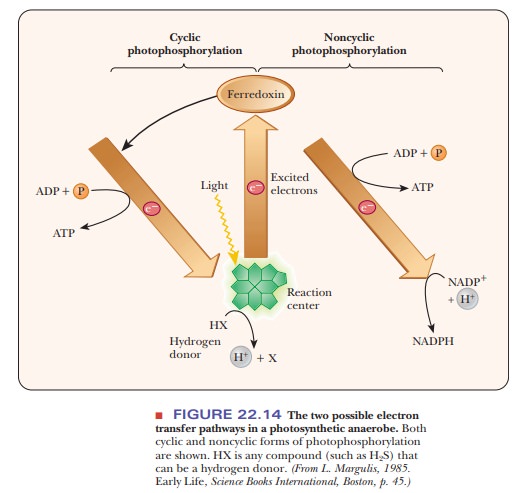Chapter: Biochemistry: Photosynthesis
Evolutionary Implications of Photosynthesis with and without Oxygen

Evolutionary
Implications of Photosynthesis with and without Oxygen
Photosynthetic prokaryotes other than cyanobacteria have only one
photosystem and do not produce oxygen. The chlorophyll in these organisms is
different from that found in photosystems linked to oxygen (Figure 22.14).
Anaerobic photosynthesis is not as efÞcient as photosynthesis linked to oxygen,
but the anaerobic version of the process appears to be an evolutionary way
station. Anaerobic photosynthesis is a means for organisms to use solar energy
to satisfy their needs for food and energy. Although it is efÞcient in the
production of ATP, its efÞciency is less than that of aerobic photosynthesis
for carbon Þxation.

Is it possible to have photosynthesis without producing oxygen?
A possible scenario for the development of photosynthesis starts with heterotrophic bacteria that contain some form of chlorophyll, probably bacteriochlorophyll. (Heterotrophs are organisms that depend on their environment for organic nutrients and for energy.) In such organisms, the light energy absorbed by chlorophyll can be trapped in the forms of ATP and NADPH. The important point about such a series of reactions is that photophosphorylation takes place, ensuring an independent supply of ATP for the organism. In addition, the supply of NADPH facilitates synthesis of biomolecules from simple sources such as CO2. Under conditions of limited food supply, organisms that can synthesize their own nutrients have a selective advantage.
Organisms
of this sort are autotrophs (not
dependent on an external source of biomolecules) but are also anaerobes. The
ultimate electron source that they use is not water but some more easily
oxidized substance, such as H2S, as is the case with present-day
green sulfur bacteria (and purple sulfur bacteria), or vari-ous organic
compounds, as is the case with present-day purple nonsulfur bac-teria. These
organisms do not possess an oxidizing agent powerful enough to split water, which
is a far more abundant electron source than H2S or organic
compounds. The ability to use water as an electron source confers a further
evolutionary advantage.
As is
frequently the case in biological oxidation-reduction reactions, hydrogens as
well as electrons are transferred from a donor to an acceptor. In green plants,
green algae, and cyanobacteria, the hydrogen donor and acceptor are H2O
and CO2, respectively, with oxygen as a product. Other organisms,
such as bacteria, carry out photosynthesis in which there is a hydrogen donor
other than water. Some pos-sible donors include H2S, H2S2O3,
and succinic acid. As an example, if H2S is the source of hydrogens
and electrons, a schematic equation for photosynthesis can be written with
sulfur, rather than oxygen, as a product.

It is
also possible for the hydrogen acceptor to be NO2- or NO3-,
in which case NH3 is a product. Photosynthesis linked to oxygen with
carbon dioxide as the ultimate hydrogen acceptor is a special case of a far
more general process that is widely distributed among many different organisms.
Cyanobacteria
were apparently the first organisms that developed the abil-ity to use water as
the ultimate reducing agent in photosynthesis. As we have seen, this feat
required the development of a second photosystem as well as a new variety of
chlorophyll, chlorophyll a rather
than bacteriochlorophyll in this case. Chlorophyll b had not yet appeared on the scene, as it occurs only in
eukaryotes. The basic system of aerobic photosynthesis was in place with
cya-nobacteria. As a result of aerobic photosynthesis by cyanobacteria, the
Earth acquired its present atmosphere with its high levels of oxygen. The
existence of all other aerobic organisms depended ultimately on the activities
of cyano-bacteria.
Summary
When photosynthesis first evolved, it was most likely to have been
carried out by organisms that used compounds other than water as the primary
electron source. Cyanobacteria were the first organisms to use water as the
source of electrons, giving rise to the present oxygen-containing atmo-sphere.
Related Topics